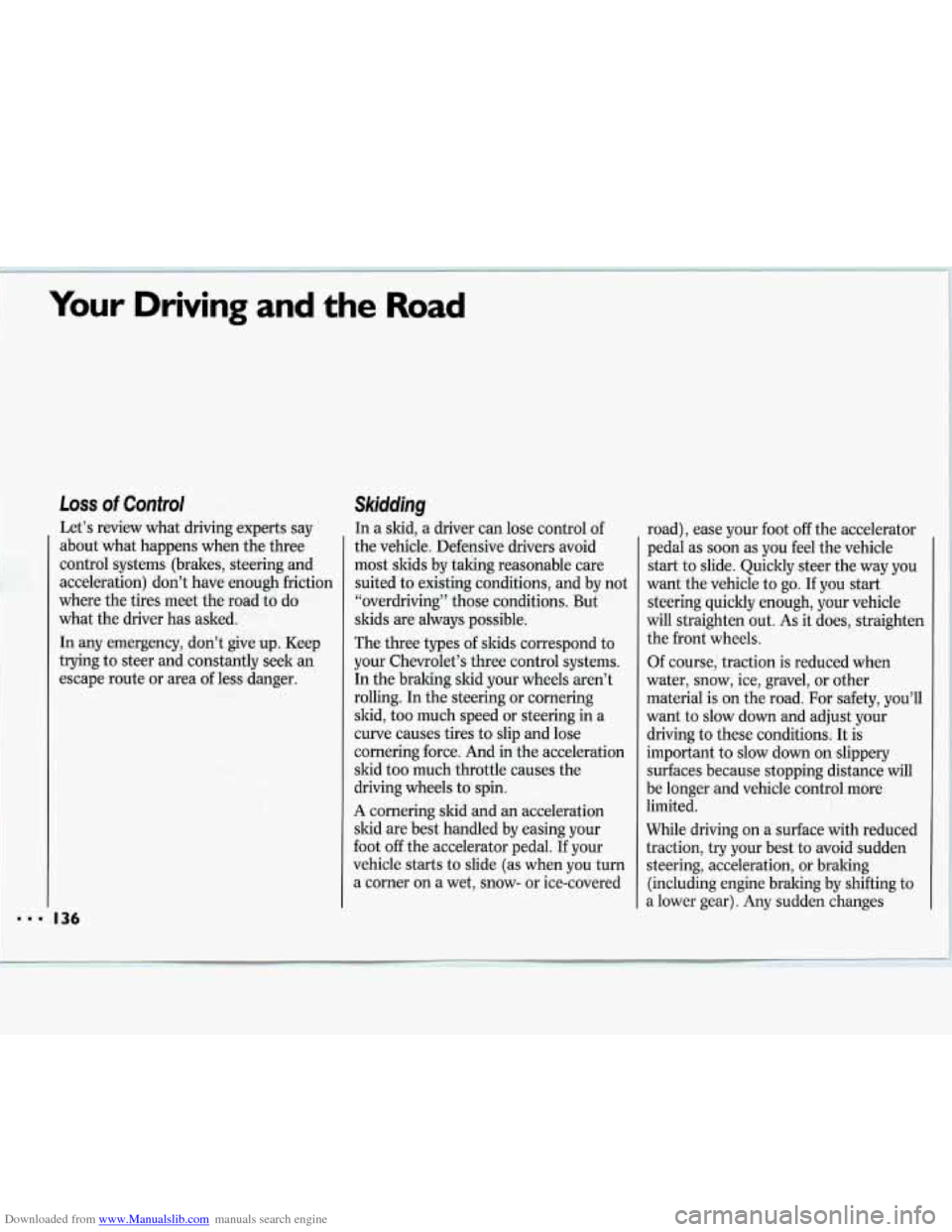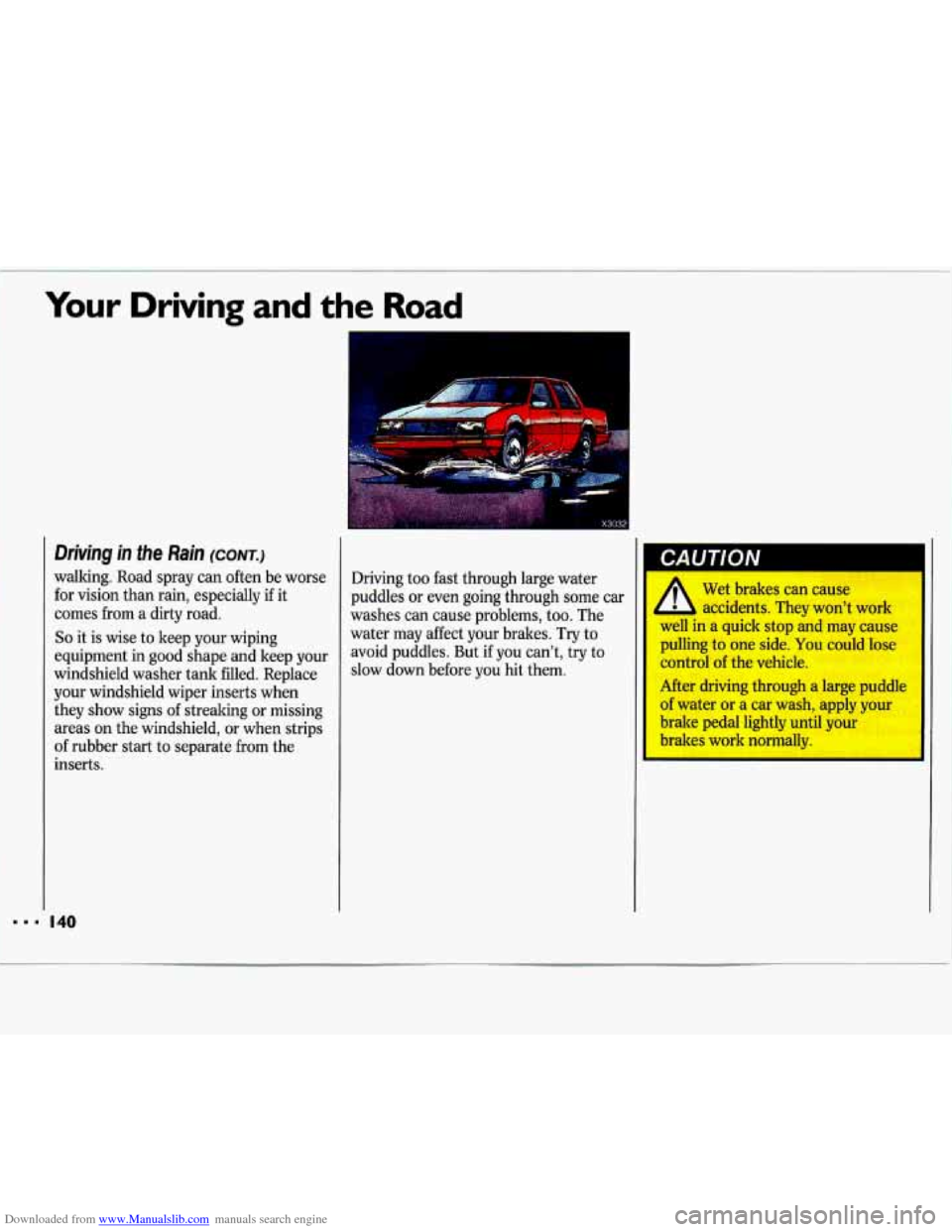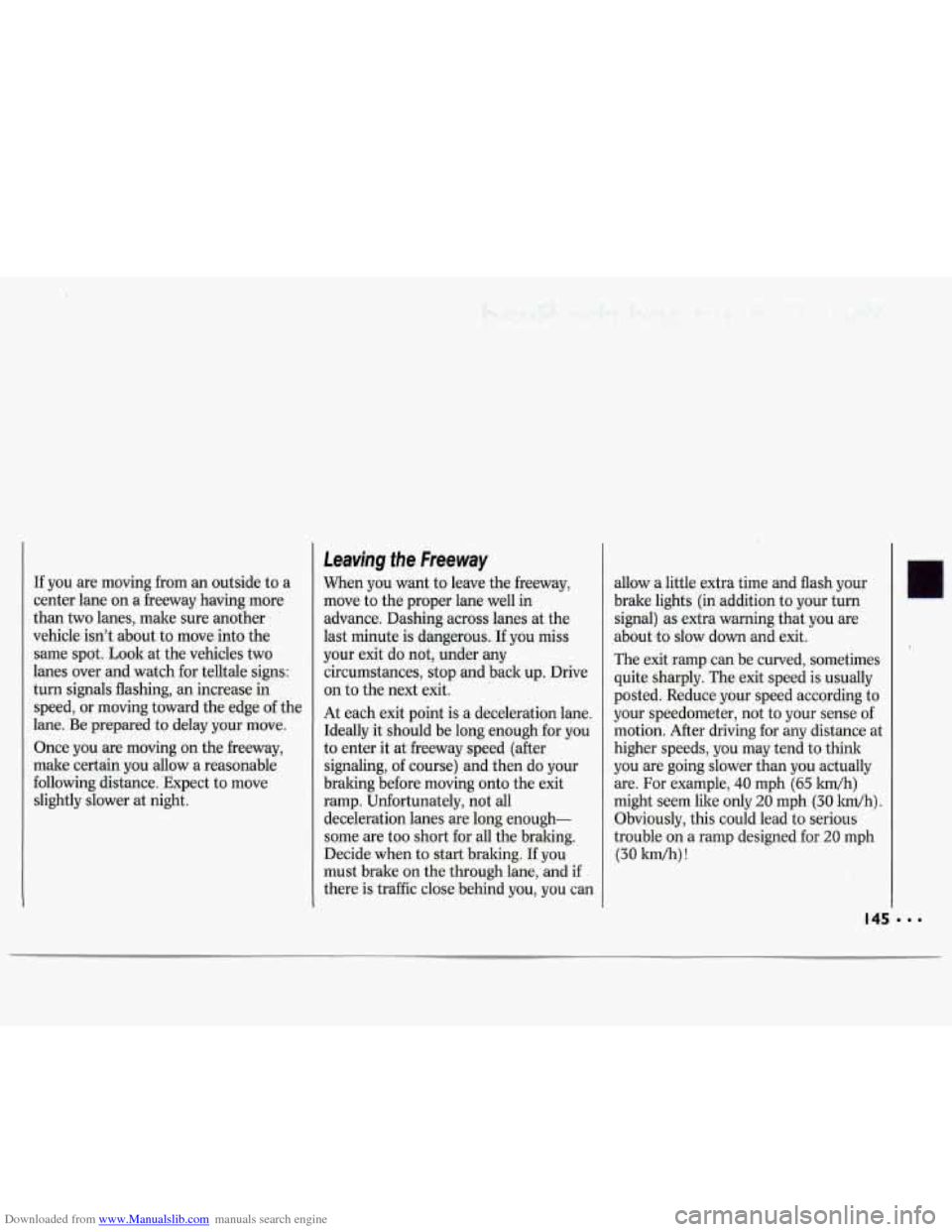1993 CHEVROLET LUMINA stop start
[x] Cancel search: stop startPage 130 of 324

Downloaded from www.Manualslib.com manuals search engine I
Your Driving and the Road
Anti-Lock Brakes (corvr.)
And this light on the instrument panel
will go on when you start your vehicle.
When you start your vehicle and begin
to drive away you may hear a
momentary motor or clicking noise and
you may even notice that your brake
pedal moves a little while this is going
on. This
is the ABS system testing itself.
If you have your foot on the brake
pedal, this check won’t happen until the
vehicle goes about
4 mph (6 km/h) or
until you take your foot off the brake
pedal. After
an
ABS stop, you may hear a
clicking noise the next time the vehicle
goes about
4 mph (6 Wh).
If there’s a problem with the anti-lock
brake system, the anti-lock brake
system warning light will stay on or
flash. See the
Index under Anti-Lock
Brake System Warning
Light.
.. .
Here’s how anti-lock works. Let’s say
the road is wet. You’re driving safely.
Suddenly an animal jumps out in front
You slam on the brakes. Here’s what
happens with
ABS.
of you.
A computer senses that wheels are
slowing down. The computer separately
works the brakes at each front wheel
and at the rear wheels.
The anti-lock system can change the
brake pressure faster than any driver
could. The computer is programmed to
make the most of available tire and road
conditions.
Page 137 of 324

Downloaded from www.Manualslib.com manuals search engine Watch for traffic signs, pavement markings, and lines. If you can see a
sign up ahead that might indicate a
turn or an intersection, delay your
pass.
A broken center line usually
indicates it’s all right to pass
(providing the road ahead is clear).
Never cross a solid line on your side
of the lane or
a double solid line, even
if the road seems empty of
approaching traffic.
If you suspect that the driver of the
vehicle you want to pass isn’t aware
of your presence, tap the horn
a
couple of times before passing.
Do not get too close to the vehicle
you want to pass while you’re
awaiting an opportunity. For one
thing, following too closely reduces
your area of vision, especially if you’re
following a larger vehicle.
Also, you
won’t have adequate space
if the
vehicle ahead suddenly slows or stops. Keep back a reasonable
distance.
When it looks like a chance to pass is
coming up, start to accelerate but stay
in the right lane and don’t get too
close. Time your move
so you will be
increasing speed as the time comes to
move into the other lane. If the way is
clear to pass, you will have a “running
start” that more than makes up for
the distance you would lose by
dropping back. And
if something
happens to cause you to cancel your
pass, you need
only slow down and
drop back again and wait for another
opportunity.
slow vehicle, wait your turn.
But tale
care that someone isn’t trying to pass
you as you pull out to pass the slow
vehicle. Remember to glance over
your shoulder and check the blind
spot.
If other cars are lined up to pass a
Check your mirrors, glance over your
shoulder, and start your left lane
change signal before moving out of
the right lane to pass. When you are
far enough ahead of the passed
vehicle to see its front in your inside
mirror, activate your right lane change signal and move back into the right
lane. (Remember that your right
outside mirror is convex. The vehicle
you just passed may seem to be
farther away from you than it really is.)
Try not to pass more than one vehicle
at a time on two-lane roads.
Reconsider before passing the next
vehicle.
vehicle too rapidly. Even though the
brake lights are not flashing, it may be
slowing down or starting to turn.
If you’re being passed, make it easy
for the following driver to get ahead of
you. Perhaps you can ease a little to
the right.
Don’t overtake a slowly moving
Page 138 of 324

Downloaded from www.Manualslib.com manuals search engine Your Driving and the Road
Loss of Control
Let’s review what driving experts say
about what happens when the three
control systems (brakes, steering and
acceleration) don’t have enough friction
where the tires meet the road to do
what the driver has asked.
In any emergency, don’t give up. Keep
trying to steer and constantly seek an
escape route or area of less danger.
136
Skidding
In a skid, a driver can lose control of
the vehicle. Defensive drivers avoid
most skids by taking reasonable care
suited to existing conditions, and by not
“overdriving” those conditions. But
skids are always possible.
The three types
of skids correspond to
your Chevrolet’s three control systems. In the braking skid your wheels aren’t
rolling. In the steering or cornering
skid, too much speed or steering in a
curve causes tires to slip and lose
cornering force. And in the acceleration
skid too much throttle causes the
driving wheels to spin.
A cornering skid and an acceleration
skid are best handled by easing your
foot
off the accelerator pedal. If your
vehicle starts to slide (as when you turn
a corner on a wet, snow- or ice-covered road),
ease your foot
off the accelerator
pedal as soon as you feel the vehicle
start to slide. Quickly steer the way you
want the vehicle to go. If you start
steering quickly enough, your vehicle
will straighten out.
As it does, straighten
the front wheels.
Of course, traction is reduced when
I 1
water, snow, ice, gravel, or other
material is on the road. For safety, you’ll
I I
want to slow down and adjust your
driving to these conditions. It is
important to slow down
on slippery
surfaces because stopping distance will
be longer and vehicle control more
limited.
While driving
on a surface with reduced
traction, try your best to avoid sudden
steering, acceleration, or braking
(including engine braking by shifting to
a lower gear).
Any sudden changes
Page 141 of 324

Downloaded from www.Manualslib.com manuals search engine Remember that your headlights light up
far less of
a roadway when you are in a
turn or curve.
Keep your eyes moving; that way, it’s
easier to pick out dimly li@ted objects.
Just as
your headlights should be
checked regularly for proper aim,
so
should your eyes be examined regularly. Some drivers suffer
from night
blindness-the inability to see in dim
light-and aren’t even aware
of it. Rain and
wet roads can mean driving
trouble.
Qn a wet road.you can’t stop,
accelerate or turn
as well because your
tire-to-road traction isn’t as good
as on
dry roads. And, ifyour tires don’t have
much tread lea, you’ll get even less
traction.
It’s always wise to go slower and be
cautious
if rain starts to fall while you
are driving. The surface may get wet
suddenly when your reflexes are tuned
for driving on dry pavement.
The heavier the rain, the harder it is to
see. Even
if your windshield wiper
blades are in good shape, a heavy rain
can make it harder to
see road signs and
traffic signals, pavement markings, the
edge of the road, and even people
Page 142 of 324

Downloaded from www.Manualslib.com manuals search engine ..I
Your Driving and the Road
Driving in the Rain (cow.)
walking. Road spray can often be worse for vision than rain, especially
if it
comes from
a dirty road.
So it is wise to keep your wiping
equipment in good shape and keep your
windshield washer tank filled. Replace
your windshield wiper inserts when
they show signs of streaking or missing
areas on the windshield, or when strips
of rubber start to separate from the
inserts.
I40
CAUTION
Driving too fast through large water
puddles or even going through some car
washes can cause problems, too. The
water may affect your brakes.
Try to
avoid puddles. But
if you can’t, try to
slow down before
you hit them.
A Wet brakes can cause
,- accidents. They won’t work
well in
a quick stop and may cause
pulling to one side.
You could lose
control
of the vehicle.
After driving through a large puddle of water or a car wash, apply your
brake pedal lightly until your
brakes work normally.
I
Page 145 of 324

Downloaded from www.Manualslib.com manuals search engine course you want to respect another’s
property, but you might need to put
something between you and moving
vehicles-space, trees, telephone poles,
a private driveway, anything that
removes you from other traffic.
If visibility
is near zero and you must
stop but are unsure whether you are
away from the road, turn your hghts on,
start your hazard warning flashers, and
sound your horn at intervals or when
you hear approaching traffic.
Pass other vehicles in fog only if you
can see far enough ahead to pass safely.
Even then, be prepared to delay your
pass if you suspect the fog
is worse up
ahead.
If other vehicles try to pass you,
make it easy for them.
Cify Driving
One of the biggest problems with city
streets is the amount of traffic on them.
You’ll want to watch
out for what the
other drivers are doing and pay
attention to traf€ic signals.
Here are ways to increase your safety in
city driving:
Know the best way to get to where
you are going.
Try not to drive around
trying to pick out a familiar street or
landmark. Get
a city map and plan
your trip into an unlmown part of the
city
just as you would for a cross-
country trip.
Try to use the freeways that rim and
crisscross most large cities. You’ll
save time and energy. (See the next
section,
Freway Driving.)
Treat a green light as a warning
signal.
A traffic light is there because
the corner is busy enough to need
it.
When a light turns green, and just
before you start to move, check both
ways for vehicles that have not
cleared the intersection or may be
running the red light.
Obey all posted speed limits. But
remember that they are for ideal road,
weather and visibility conditions.
You
may need to drive below the posted
limit in bad weather or when visibility
is especially poor.
Pull to the right (with care) and stop
clear of intersections when you see or
hear emergency vehicles.
Page 147 of 324

Downloaded from www.Manualslib.com manuals search engine If you are moving from an outside to a
center lane on a freeway having more
than two lanes, make sure another
vehicle isn’t about to move into the
same spot. Look at the vehicles two
lanes over and watch for telltale signs:
turn signals flashing, an increase in
speed, or moving toward the edge
of the
lane. Be prepared to delay your move.
Once you are moving on the freeway,
make certain you allow
a reasonable
following distance. Expect to move
slightly slower at night.
Leaving the Freeway
When you want to leave the freeway,
move to the proper lane well in
advance. Dashing across lanes at the
last minute is dangerous. If you miss
your exit do not, under any
circumstances, stop and back up. Drive
on to the next exit.
At each exit point is a deceleration lane.
Ideally it should be long enough for you
to enter it at freeway speed (after
signaling,
of course) and then do your
braking before moving onto the exit
ramp. Unfortunately, not all
deceleration lanes are long enough-
some are too short for all the braking.
Decide when to start braking. If you
must brake on the through lane, and if
there is traffic close behind you, you can allow a little extra time and flash your
brake lights (in addition to your turn
signal) as extra warning that you are
about
$0 slow down and exit.
The exit ramp can be curved, sometimes quite sharply. The exit speed is usually
posted. Reduce your speed according to
your speedometer, not to your sense of
motion. After driving for any distance at
higher speeds, you may tend to think
you are going slower than you actually
are. For example,
40 mph (65 lun/h)
might seem like only
20 mph (30 lmih).
Obviously, this could lead to serious
trouble on a ramp designed for
20 mph
(30 Wh)!
Page 162 of 324

Downloaded from www.Manualslib.com manuals search engine Your Driving and the Road
Driving with a Trailer (CONT.)
Making Turns
When you’re turning with a trailer, make wider turns than normal. Do this
so your trailer won’t strike soft
shoulders, curbs, road signs, trees, or
other objects. Avoid jerky or sudden
maneuvers. Signal well in advance.
Turn Signals When Towing a Trailer
When you tow a trailer, your vehicle has
to have a different turn signal flasher
and extra wiring. The green arrows on
your instrument panel will flash
whenever you signal a turn or lane
change. Properly hooked up, the trailer
lights will also flash, telling other
drivers you’re about to turn, change
lanes or stop.
I60
When towing a trailer, the green arrows
on your instrument panel will flash for
turns even if the bulbs on the trailer are
burned out. Thus, you may think
drivers behind you are seeing your
signal when they are not. It’s important
to check occasionally to be sure the
trailer bulbs are still working.
Your vehicle has bulb warning .lights.
When you plug trailer lights into your
vehicle’s lighting system, its bulb
warning lights may not let you know if
one
of your lights goes out. So, when
you have trailer lights plugged in, be
sure to check your vehicle and trailer
lights from time to time to be sure
they’re all working. Once you disconnect the trailer lights, the bulb
warning lights again can tell you if one
of your vehicle lights
is out.
Driving On Grades
Reduce speed and shift to a lower gear
before you start down a long or steep
downgrade. If you don’t shift down,
you
might have to use your brakes so much
that they would get hot and no longer
work well.
On a long uphill grade, shift down and
reduce your speed to around
45 mph
(70 Wh) to reduce the possibility of
engine and transaxle overheating.
If you are towing a trailer and you have
an automatic transaxle with Overdrive,
it’s best to drive in
D instead of (or,
as you need to, a lower gear). This will
minimize heat build-up and extend the
life of your transaxle.